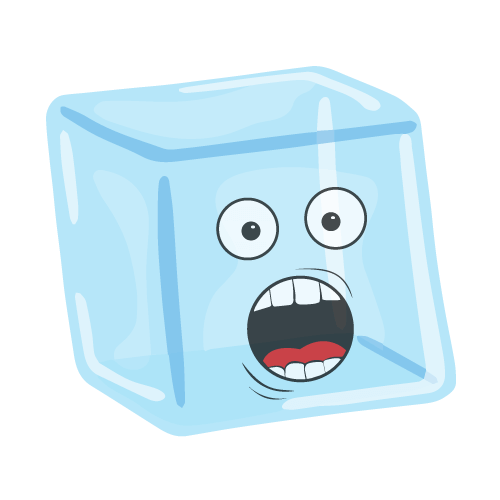In recent years, workplace personality tests have become a common occurrence in corporate environments. This is especially true for successful companies, and the stats speak for themselves. Did you know that up to 80% of Fortune 500 companies and 89% of the Fortune 100 companies have used the Myers-Briggs Type Indicator (MBTI)?
And while including a wide range of such personality assessment tools in various corporate contexts (like the pre-hire and post-hire processes, for instance) is strongly encouraged, identifying the right tests can be a challenge.
And that’s where we step in with the 10 best workplace personality tests for teams.
But let’s answer some key questions first…
What is a Workplace Personality Test?
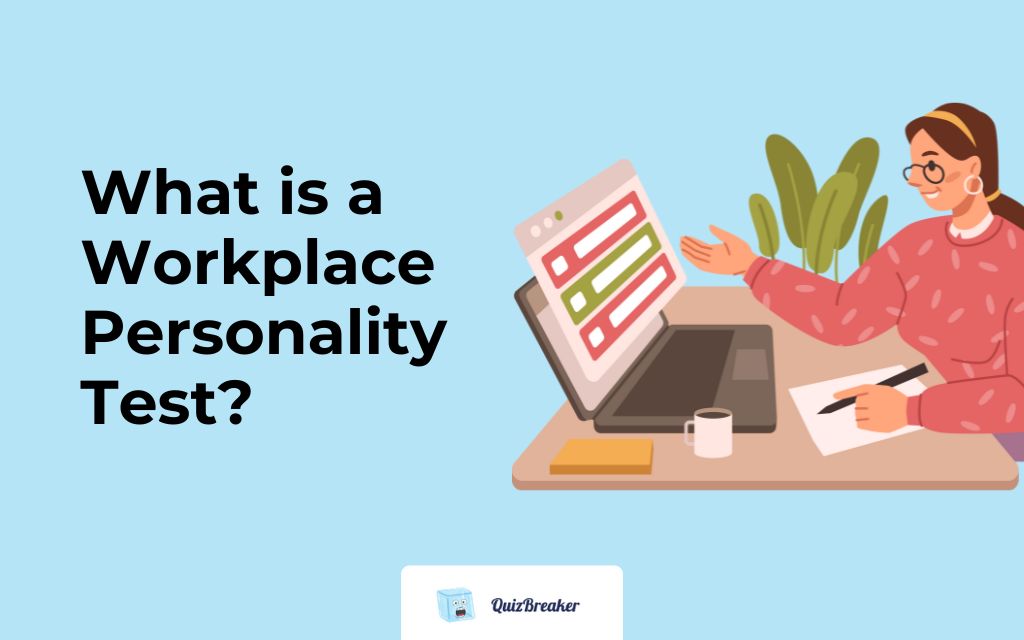
Workplace personality tests are insightful assessment tools designed to tell you more about an individual’s personal attributes, most especially work-related motivations, methodologies, interpersonal dynamics, and so on.
Organizations often employ workplace personality tests during the recruitment process because they help identify candidates who fit the existing company culture and contribute positively to it. For established teams, you can also run these assessments after-the-fact to create a more firm sense of unity and shared understanding.
In this article, we’ll look at personality tests in more professional settings, mainly around Learning and Development (L&D) contexts. We’ll also study how these assessments can cultivate your interpersonal relationships and promoting employee development.
Top 10 Best Workplace Personality Tests for Teams
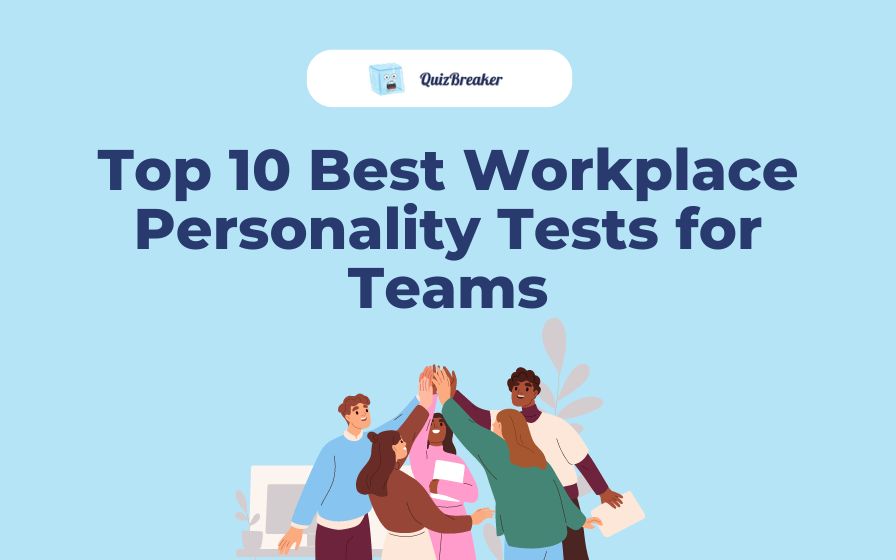
In the following paragraphs, we’ll share the ten best workplace personality tests for teams.
We’ll explain what each of them looks like, what it measures, and how it can benefit your workplace. Then it’s up to you to choose the one(s) that resonate(s) for you and your team.
Let’s begin, shall we?
1) WorkStyle
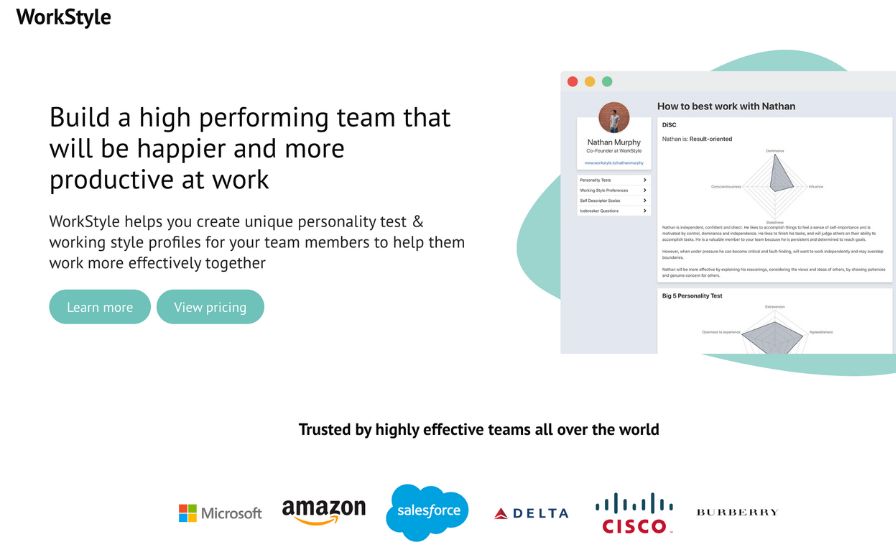
Best for: Teams that need a versatile tool with multiple personality assessments in one platform.
The first workplace personality test tool for teams on this list is WorkStyle, an online platform that helps you create personality test and working style profiles. It's a great service for teams that want one place to aggregate team personality results, preferences, and working styles so that everyone understands each other better.
WorkStyle isn't necessarily a personality test for teams, but it's a great tool that gives you access to eight personality tests in one platform. Those tests include some highly acclaimed ones like:
-
Big 5
-
DiSC
-
Jungian
-
Achievement Orientation
-
Occupational Emotional Intelligence
-
Self Efficacy
-
Empowering Leadership
-
Project Management
On top of having personality tests for teams, Workstyle also has a bunch of other highly helpful features, like fun icebreakers through a 100+ questionnaires that will help your employees know a little bit more about their team mates. Your team can also use certain scales for categories like Communication & Management Styles, Work Standards, and Working Relations to give more context to how each team member can work better with the other.
Where can I find the test?
To access the eight personality tests, workstyle preference profiles, working scales, and other features of Workstyle, you can head over to their website.
2) The Myers-Briggs Type Indicator
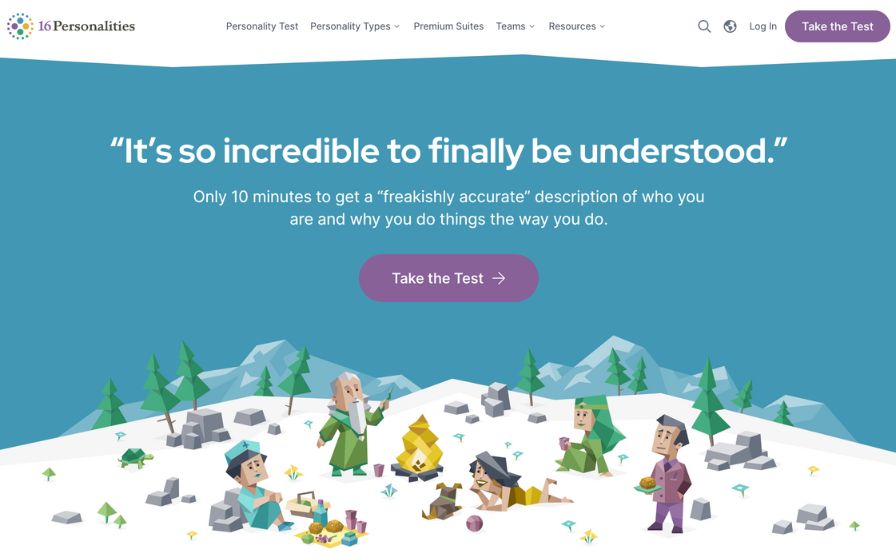
Best for: Organizations looking to improve team dynamics and individual understanding.
The Myers-Briggs Type Indicator (MBTI) was developed by two American writers, Katharine Cook Briggs and her daughter Isabel Briggs Myers. The test is a type of self-report questionnaire which analyzes how people perceive the world around them and make decisions.
MBTI assigns test-takers 4 categories, which are polar extremes, out of the following 8 categories: introversion (I) or extraversion (E), thinking (T) or feeling (F), sensing (S) or intuition (N), and judging (J) or perceiving (P). At the end of the test, each participant is given a specific profile out of 16 different possibilities.
Here’s what it would look like:
INTJ: introversion (I), intuition (N), thinking (T), and judging (J).
The result resembles a code with four letters. Here are all 16 personality types:
-
ISTJ - The Inspector;
-
ISTP - The Crafter;
-
ISFJ - The Protector;
-
ISFP - The Artist;
-
INFJ - The Advocate;
-
INFP - The Mediator;
-
INTJ - The Architect;
-
INTP - The Thinker;
-
ESTP - The Persuader;
-
ESTJ - The Director;
-
ESFP - The Performer;
-
ESFJ - The Caregiver;
-
ENFP - The Champion;
-
ENFJ - The Giver;
-
ENTP - The Debater;
-
and ENTJ - The Commander.
But this isn’t everything. Each type comes with a concise explanation. For instance, if your employee ends up being the ISTP type, here’s what their explanation would look like: “Tolerant and flexible, quiet observers until a problem appears, then act quickly to find workable solutions. Analyze what makes things work and readily get through large amounts of data to isolate the core of practical problems [...].
The whole point of the Myers-Briggs Type Indicator is to help people get to know themselves better and appreciate each other’s differences. Make sure to accentuate that all personality types matter equally, and one isn’t necessarily better than the other. This is precisely what makes this assessment great for corporate teams.
Where can I find the test?
To get access to the Myers Briggs Type Indicator, visit 16 Personalities.
3) DISC

Best for: Businesses that want to enhance workplace communication and teamwork.
DISC stands for Dominance, Inducement, Submission, and Compliance. These are the four central traits that describe a person’s character. Each person has all four traits; it’s just that some are more dominant than others. Here’s what each of them means in greater detail:
-
Dominance - individuals who actively use force to overcome any resistance; they’re also quite confident and have a tendency to accomplish their goals;
-
Inducement - people who have this as their dominant trait are able to persuade others quite easily and use their charm to achieve their goals;
-
Steadiness - these people are dependable, have no problem fulfilling others’ requests, and focus on collaboration;
-
Compliance - this trait depicts personalities that are concerned with notions like expertise, competency, quality, and so on.
In general, DISC assessments are tests that examine how an individual ranks in these four areas of behavior we just listed. They’re based on the psychologist William Moulton Marton’s 1928 emotional and behavioral theory.
The test allows employers to gain deeper insights into their workers. They’re great for teams, especially when one needs to analyze specific team members and how they collaborate together, as well as how their different traits interact with one another.
For instance, one team member may score highly in submission and compliance, whereas another one may have the same score in the other two areas - dominance and inducement. If you don’t understand where your workers are coming from and they don’t understand each other’s behaviors, this may lead to unnecessary friction and arguments in the team. That’s why such assessments can be truly insightful. Identifying how each worker ranks facilitates easier conflict resolutions, better communication among peers, and a much healthier work environment.
It’s worth noting that one personality trait isn’t better than another one, and none of them are positive or negative - one should be “non-judgmental” toward the results and simply take them as they are.
Where can I find the test?
You can get access to the DISC assessment as part of the WorkStyle license.
4) CliftonStrengths
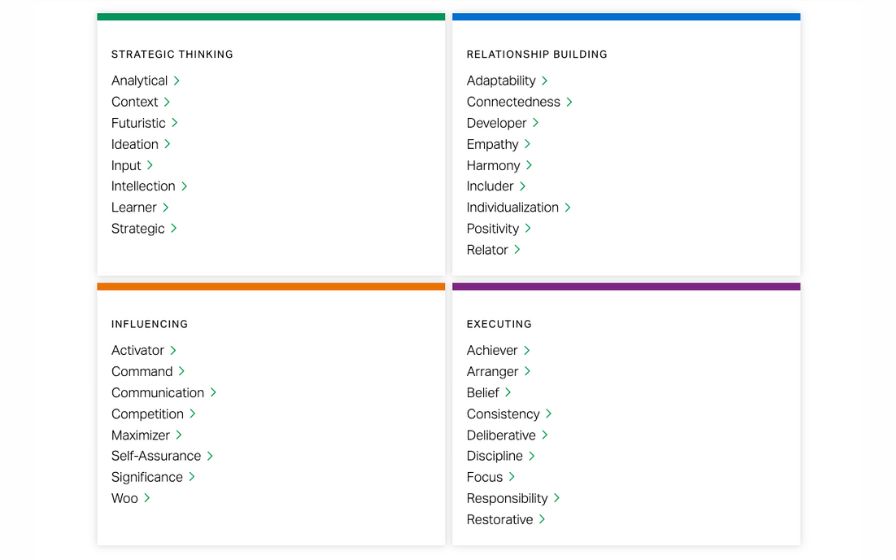
Best for: Individuals and teams that want to leverage personal strengths for career development and team efficiency.
Formerly known as the StrengthsFinder, CliftonStrengths is an assessment developed by Donald Clifton, an educational psychologist. Clifton’s interest was in understanding the strengths that enable individuals to be outstanding, which led to him creating this assessment.
What makes this assessment so interesting is that there’s a 20-second timer for each statement. Then, the test automatically moves to the next one. The purpose of this is not to give individuals time to overthink their answers, which is believed to assist with the test’s accuracy.
After a test-taker completes the CliftonStrengths test, they receive a personalized report. The assessment determines the ranking order of 34 themes. Each of them describes a particular personality type, and they’re classified into the following four categories:
-
strategic thinking;
-
relationship building;
-
influencing;
-
and executing.
In essence, the test results are meant to help test-takers understand why they are the way they are and what they can do to accentuate their strengths.
This assessment is amazing for employers who wish to identify top performers in their workplace and analyze specific members and their unique personality traits within their company. After all, it’s no secret that top-performing companies embrace versatile strengths and personality traits to achieve greater success.
Where can I find the test?
You can buy the CliftonStrengths test on their official website.
5) Enneagram Test
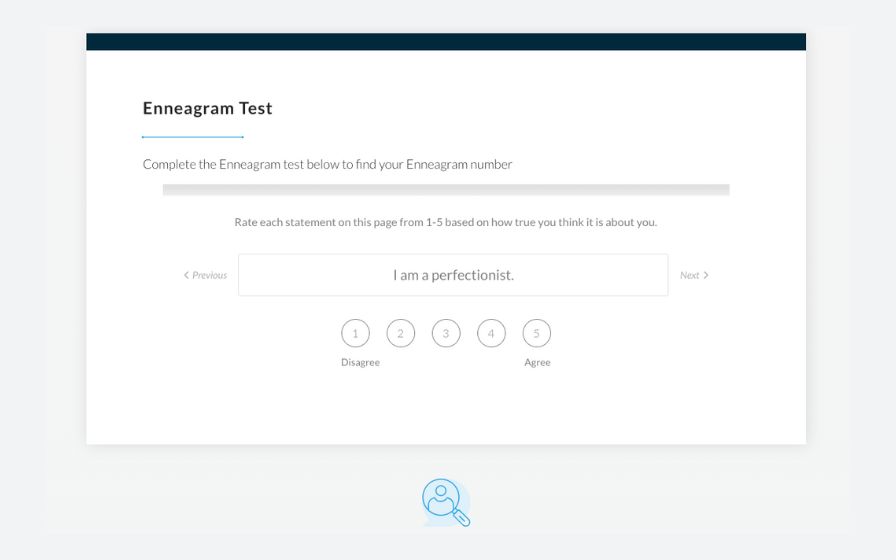
Best for: Personal development and team building exercises that require deep psychological insights into personality archetypes.
The Enneagram test provides test-takers with detailed personality assessments based on nine personality types that describe common individual behaviors, motivations, overall tendencies, desires, etc. And while each personality type has its own qualities, there are variations within each of them. These variations are referred to as “wings”. So, for example, if someone’s personality profile suggests they’re predominantly a type 3, they might have some qualities commonly found in type 4 and/or even 5.
In the following paragraphs, we analyze each one of these nine personality types.
Enneagram Type 1: Idealist
An idealist is a person who is ethical, a perfectionist, and wishes to help others. They’re positive, honorable, and tend to do good. They appreciate honesty and wish to be taken seriously.
These individuals have a lot of fear of being immoral or unethical in any way.
Enneagram Type 2: Caregiver
Caregivers want to receive both love and affection from those around them. They’re hard workers and are led by their emotions in life. These individuals are quite generous, warm-hearted, and want to help whenever they can.
Their biggest fear is to be unworthy of being loved. Also, caregivers need attention and frequent encouragement.
Enneagram Type 3: Performer
Individuals with this personality trait are on a quest to achieve great things in life. They’re charismatic, flexible, and enjoy following a well-outlined plan. They do wish to receive affirmation from other people, though.
Performers are highly ambitious and energetic individuals. Their basic desire is to be important and worthy, whereas their basic fear is to be seen as useless or insignificant.
Enneagram Type 4: Creative
Creative people appreciate authenticity both in themselves and others. They’re highly sensitive and appreciate art in all forms. Creative individuals are self-aware, dramatic, and crave the freedom to be themselves at all times. In fact, their basic fear is being left without their personal identity.
Fours need space to recharge and replenish their energy so that their personal identity can shine.
Enneagram Type 5: Thinker
Thinkers are thoughtful individuals who wish to be valuable and be on their own. They’re highly introspective and curious, ask a lot of questions, appreciate the knowledge they possess, and want to engage in direct communication.
Their basic fear is around being seen as incompetent or unskilled.
Enneagram Type 6: Loyalist
Type 6 individuals appreciate consistency and safety. They’re trustworthy and make logical and reliable decisions. Loyalists are responsible, cautious, and loyal (hence the name).
They place great importance on being able to express themselves without any restrictions, and their basic fear is losing their support and security.
Enneagram Type 7: Adventurer
Adventurers want to experience everything the world has to offer them. They want to have fun, try exciting things, and always plan their next move. These individuals want to be joyful and fulfilled, and their basic fear is being deprived of an opportunity.
Sevens are full of out-of-the-box ideas, have an open-minded approach toward life, and appreciate positive communication with others.
Enneagram Type 8: Protector
Put simply, protectors want to be in control of their lives. They are very strong, make decisions quickly, and have no problem leading the way for others. They’re confident and highly assertive, appreciate straightforward communication with others, and are fond of strong and logical ideas.
Type 8 individuals’ basic desire is to be free and protected. Their basic fear is being hurt or controlled.
Enneagram Type 9: Peacekeeper
Peacekeepers, as their name suggests, want to be at peace both with themselves and the people in their life. They’re agreeable, able to consider various perspectives, and highly adaptable. Such people are optimistic and their basic fear is being separated from the world.
These individuals want to engage in peaceful interactions, provide thorough feedback, and listen to others’ ideas.
Where can I find the test?
You can find the Enneagram Test on Truity.
6) Hogan Personality Inventory
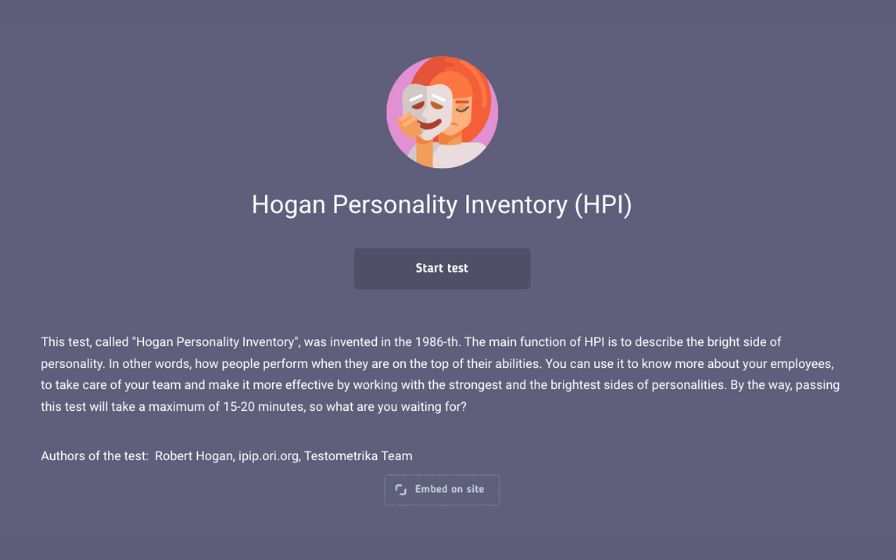
Best for: High-stakes environments that require personality assessments to predict job performance and leadership potential.
Created in the 80s, The Hogan Personality Inventory, or HPI, is based on the Five-Factor Model of Personality devised by the personality psychologists Robert McCrae and Paul Costa.
The HPI describes a person’s “bright” personality - or how people behave toward others when they’re at their best. The HPI assessment takes into account 7 personality traits or scales (and 42 subscales):
-
ambition;
-
sociability;
-
interpersonal sensitivity;
-
prudence;
-
inquisitiveness;
-
learning approach;
-
and adjustment.
If employees get a high score on the Sociability scale, they’re regarded as talkative and outgoing; if they get a low score, they’re described as individuals who work independently and tend to be quiet.
It’s worth saying that this is one of those workplace personality tests which can be used in different corporate contexts. For instance, potential job candidates can take the assessment to see if they’re a good fit for the workplace they’re applying for, HR professionals may use it to check if employees can further develop within their roles or if it’s time for them to move up within the company.
Where can I find the test?
You can take the assessment here.
7) Keirsey Temperament Sorter
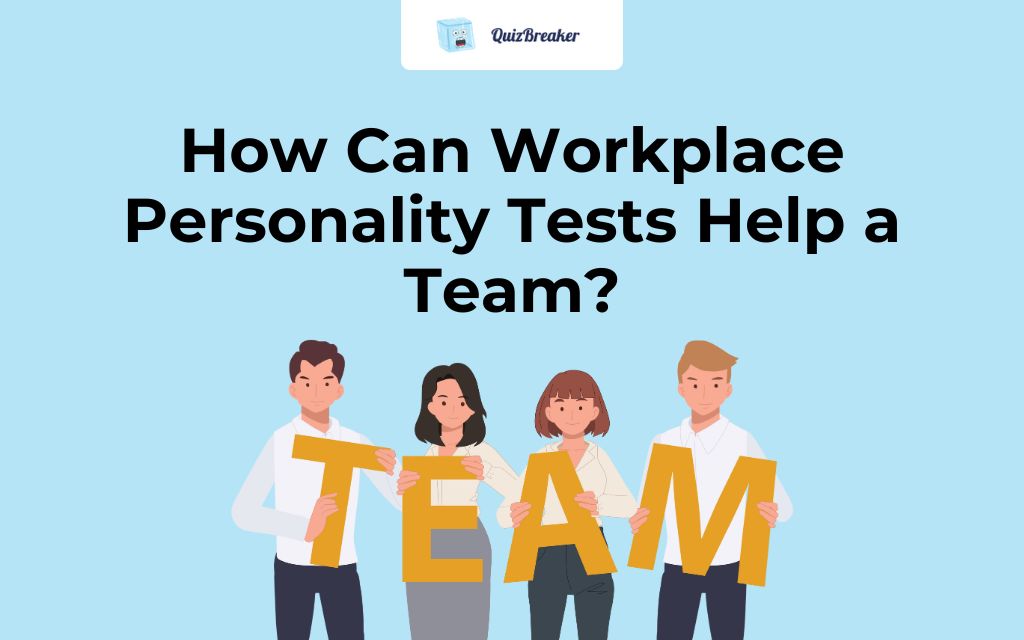
Best for: Team collaboration and conflict management based on temperament-based behavioral tendencies.
The Keirsey Temperament Sorter (KTS) is a personality questionnaire created to help people understand themselves and those around them. KTS was developed by Dr. David Keirsey, a psychologist, and it was first published in the book Please Understand Me (1978).
Temperament is understood as a configuration of one’s communication methods, noticeable personality traits, ways of taking action, values, attitudes, etc.
Each temperament comes with its own set of authentic strengths and shortcomings. The Keirsey Temperament Sorter identifies four such temperaments:
-
The Artisan. such people are said to be excited, playful, adaptable, daring, persuasive, enticing, optimistic, impulsive, adaptable, and tactical;
-
The Guardian. these are individuals who are respectable, factual, cautious, concerned, dependable, law-abiding, steady, logistical, and detailed;
-
The Idealist. test-takers who identify with this temperament are authentic, imaginative, romantic, empathetic, intuitive, kind-hearted, sensitive, relational, and diplomatic;
-
and The Rational. these individuals are described as calm, ingenious, innovative, logical, curious, independent, strategic, pragmatic, and systemic.
With that said, Keirsey’s four temperaments can be subdivided even further. As such, they’re referred to as “personality types” or “character types”. So, if test-takers fall in the Artisan category, there are four kinds of Artisans that should be considered: Artisan Promoter (ESTP), Artisan Performer (ESFP), Artisan Crafter (ISTP), and Artisan Composer (ISFP).
How can this temperament classification help your company, job performance assessment, or help you understand each of your employees’ individual personalities?
Namely, Keirsey concluded that individuals’ distinct core pursuits depend on their temperament. Each person feels what’s best for them, what goals they wish to pursue, as well as the methods they need to get there. Put simply, each of these four temperaments takes people on a different path of ambition and self-discovery.
Moreover, the test is very useful for employers, too. It allows them to identify clashes between employees and navigate through communication issues (after all, the whole test revolves around people’s temperaments, so it’s only natural for the test to provide insights into how individuals behave in situations where their temperaments are brought to the surface).
Lastly, the Keirsey Temperament Sorter is very often compared to the Myers-Briggs Type Indicator. While it’s true they may share some commonalities, they also differ in some ways. For instance, the Myers assessment mostly focuses on how individuals feel and think, whereas Keirsey’s main focus is on how people behave.
Also, Myers’ descriptions seem to be much more linear and straightforward, while Keirsey’s tend to be part of a much more complex system.
On the whole, this workplace personality test is worth checking out - after all, the Keirsey Group is trusted by more than 75% of Fortune companies.
Where can I find the test?
Click on this link to get started, or check out this free sample here.
8) Big 5 Personality Test
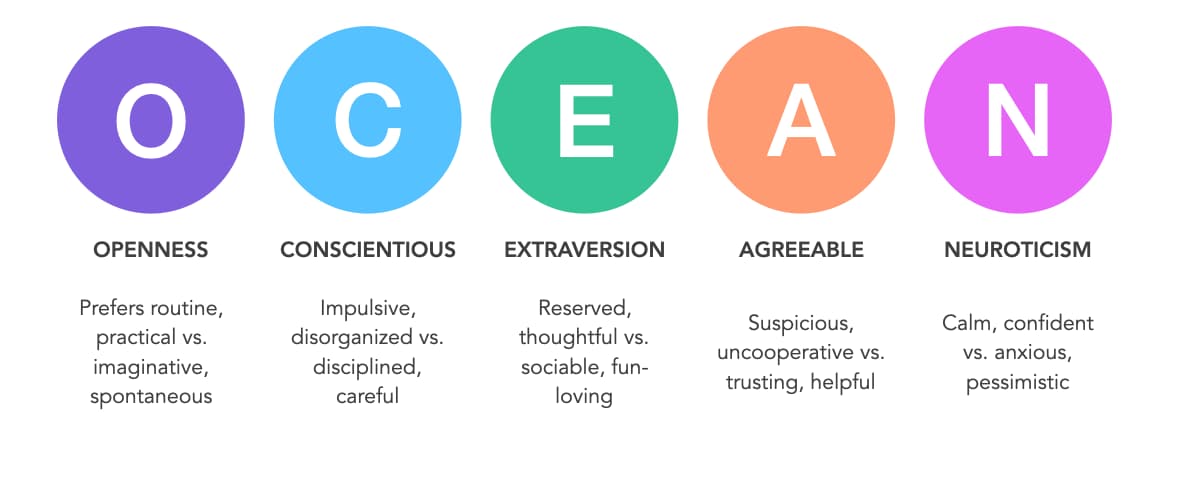
Best for: Comprehensive personality profiling.
The Big 5 Personality test, also referred to as the Five Factor, or the OCEAN personality type model, states that each person has five core personality traits (or dimensions). They’re:
-
openness;
-
conscientiousness;
-
extraversion;
-
agreableness;
-
and neuroticism.
Alternatively, many often use the acronym CANOE when referring to these five traits. It’s the same OCEAN personality type model we just mentioned - it’s just the order of the letters that’s different.
We suggest going through them in greater detail as this will help you better understand this type of workplace personality test.
1) Openness
This trait denotes an individual who has a lot of insight and imagination. Such people also have a plethora of interests and are keen to learn new things. People who score high in this trait are quite creative, open to new challenges, and understand abstract concepts.
On the other hand, those who score low in this trait tend to dislike changes, resist any new ideas, aren’t imaginative, and aren’t interested in trying out new things.
2) Conscientiousness
As a trait, conscientiousness includes controlling one’s impulses, having high thoughtfulness levels, and moving toward one’s goals. Conscientious individuals are organized, take into account details, and plan matters ahead. They also understand how their behaviors affect other people and don’t struggle with deadlines.
Such people also finish significant tasks without any delays and enjoy having a fixed schedule and sticking to it. That said, those who score quite low in this trait fail to finish important tasks (or procrastinate very often), aren’t fond of schedules, and complicate things unnecessarily.
3) Extraversion
People who score high in this trait are outgoing individuals and always come across as energized (especially in social situations). They like being around people and enjoy being the center of attention. Such people have no problem initiating conversations, meeting new people, and having a big circle of friends.
Those who score low in this trait, however, tend to be much more reserved and don’t enjoy spending a lot of time in social contexts. Social events feel quite draining for them, which is why they require more solitude. They also dislike engaging in small talk, can’t stand being the center of attention, and don’t feel like starting conversations.
4) Agreeableness
This personality trait denotes notions such as altruism, affection, trust, and kindness. Individuals who score high in agreeableness are cooperative, deeply care about others, are able to feel empathy, and help others in need of assistance. They know how to properly contribute to others’ happiness, too.
Individuals with low levels of agreeableness have little or no interest in others, manipulate people to achieve what they want, and don’t really care about other people’s feelings. They also might belittle or insult others.
5) Neuroticism
This final fifth trait is characterized by emotional instability, sadness, and irritability. Those who score high in this trait deal with anxiety and mood swings, and get upset quite frequently. They also worry about many things and have a lot of stress in their life.
Those who score low in neuroticism are much more stable and show emotional resilience. They cope with stress well, don’t overthink or worry too much, tend to be relaxed, and experience feelings of depression or sadness very rarely.
Finally, this workplace personality test is great for employers who wish to learn more about their new hires. The test results can help shed light on the potential employee’s personality, the job performance you can expect, and more importantly, how well they can adjust to your already established teams.
Where can I find the test?
You can find the test on WorkStyle, as it’s part of the personality tests package, or you can check Truity.
9) Minnesota Multiphasic Personality Inventory
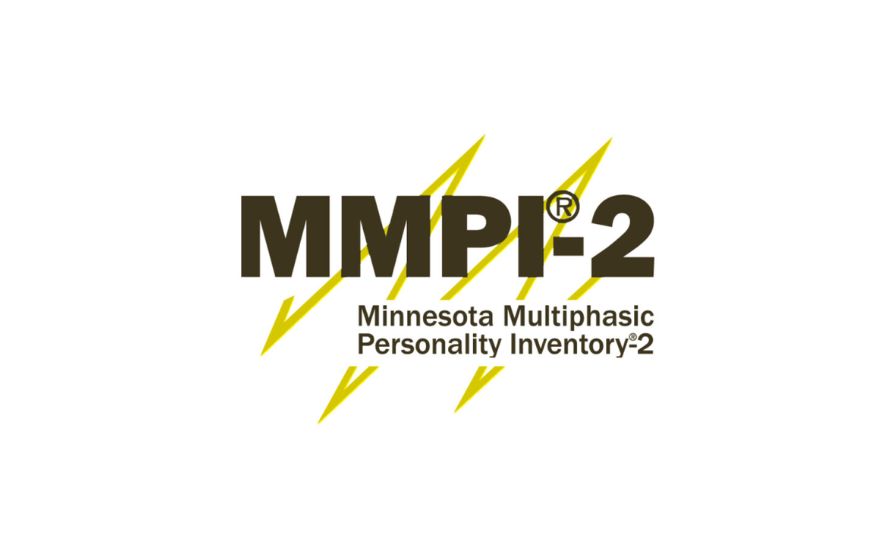
Best for: Clinical settings and high-security job screenings where psychological stability and personality assessment are crucial.
Many perceive the Minnesota Multiphasic Personality Inventory (MMPI) test to be quite complicated, as it underwent a lot of changes and versions to be what it is today. It was originally developed by an American neurologist, J. C. McKinley, and an American psychologist, Starke R. Hathway.
Initially, the test was used to assess a person’s mental health and give a diagnosis, and later it started being used in non-clinical contexts as well, such as a screening tool for certain professions (especially high-risk jobs) to assess the candidates’ psychological stability. This, however, caused some controversy due to the way the test was initially perceived.
Currently, the test is administered in one of its two existing forms - the so-called MMPI-2, which consists of 567 true/false questions, and the newer form, the MMPI-2-RF version, which includes 338 true/false items.
Although the MMPI-2-RF version is much quicker to complete, the MMPI-2 is still much more widely used due to its familiarity among psychologists and an already existing research base.
The test has the so-called 10 clinical scales. Each one of them indicates a separate psychological condition. Although each scale comes with a different name, oftentimes, people just refer to the scales by using their respective numbers, as many of the conditions are said to have overlapping symptoms.
Below we share a bit more about each of them.
Scale 1 - Hypochondriasis
This scale was created to assess body concerns and overall bodily functioning matters, which is why the items listed on this scale deal with physical symptoms and well-being matters. After all, it makes sense - the scale was originally developed to help identify individuals with symptoms of hypochondria.
Scale 2 - Depression
This scale was created with the intention of identifying depression. Very high scores confirm depression, whereas somewhat moderate scores tend to suggest dissatisfaction with one’s life.
Scale 3 - Hysteria
The purpose of this scale was to identify people who exhibit hysteria or physical complaints in some stressful moments.
Well-educated individuals tend to score higher on this scale. It’s alleged that women score higher than men.
Scale 4 - Psychopathic Deviate
This scale was created to single out people with psychopathic tendencies. The scale is said to measure the lack of acceptance of any authority, social deviation, and amorality.
Those who score higher are usually much more rebellious, while those with lower scores are much more adaptable and accepting of authority.
Scale 5 - Masculinity-Femininity
The fifth scale was supposed to discover homosexual tendencies (however, it turned out to be ineffective).
Nowadays, the scale measures how much or how little an individual identifies with the stereotypical female and male gender behaviors, interests, and roles.
Scale 6 - Paranoia
This scale singles out people with paranoid-like symptoms, excessive sensitivity, suspiciousness, and so on.
Individuals who score quite high on this scale usually have psychotic or paranoid symptoms.
Scale 7 - Psychasthenia
This seventh scale isn’t used today. However, the symptoms that are connected with this scale resemble those of depression, anxiety, extreme worry, and OCD.
Scale 8 - Schizophrenia
This scale was initially developed to discover people with schizophrenia. However, now it stands for a plethora of areas, such as social alienation, weird thought patterns, poor family relationships, impulses, difficulty concentrating, and others.
Scale 9 - Hypomania
The ninth scale was created to single out individuals with hypomania characteristics, including hallucinations, elevated mood, and irritability, to name a few.
Scale 0 - Social Introversion
The last scale was created much later than the previous nine scales.
It was designed to track a person’s shyness and habits of withdrawing from social responsibilities and interactions.
All in all, this test benefits the workplace by assessing candidates’ personalities and credibility. It also helps with sorting candidates for different key positions within the company.
Where can I find the test?
You can take the test here.
10) Test Color
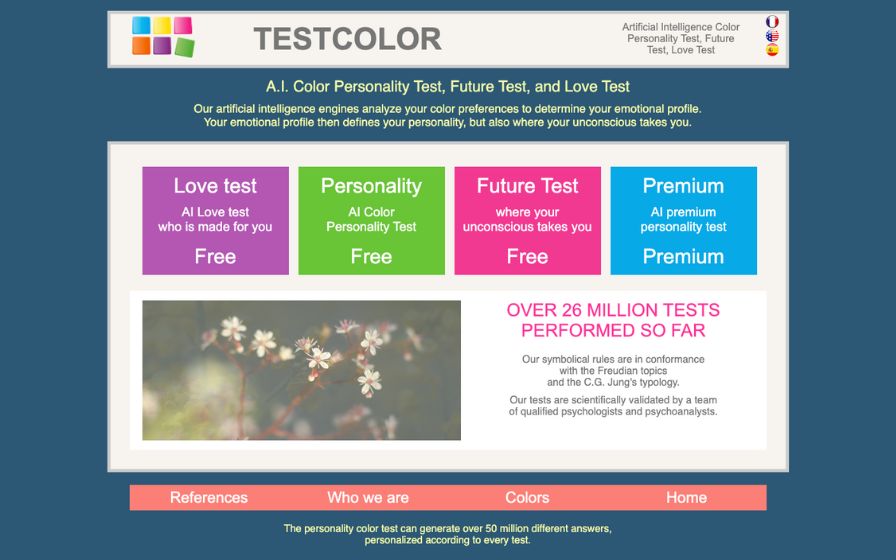
Best for: Quick and visually engaging personality insights, ideal for workshops and informal team-building activities.
Colors can reveal one’s emotions, and emotions reveal one’s personality. At least that’s what Test Color claims. And with more than 23 000 000 tests taken thus far, we dare say they know what they’re talking about.
The color test, which is made in accordance with Jung’s typology and Freud’s approach, is capable of generating more than 50 million different answers, customized according to each test-taker. Moreover, their assessments are validated by qualified psychoanalysts and psychologists, further proving the test’s validity.
Here are the premises upon which this type of assessment rests. Allegedly, emotions are said to always tell the truth. When we find ourselves in front of symbols, colors, and similar objects, they tend to trigger emotions within us. These emotions then determine our preferences.
The classic personality assessments are seen as somewhat flawed in the sense that test-takers always try to present themselves in the best light possible. This approach, however, manages to disable such subjectivity. It’s very difficult to manipulate the answers when you don’t quite understand what each symbol or color stands for in the final test results.
Once a person takes the test, they receive:
A detailed personality description.
This is a 20+ page report with personalized information which describes the individual’s personality in a very detailed way.
A professional profile.
This includes the person’s detailed professional profile with content such as strengths, overall qualities, weaknesses, and more.
Personality types.
Consistent with both Jung’s model and the color personality types model.
Lifestyle.
This final bit consists of the most important components that make up that person’s character, evolution, and overall choices throughout life. It also deals with how the person impacts those around them and how others perceive them.
All in all, this workplace personality test is a great option for employers who wish to provide their teams with a creative assessment and take a break from the traditional personality assessments.
Where can I find the test?
You can take this workplace personality test on this website.
How Can Workplace Personality Tests Help a Team?

Personality assessments have many functions in the workplace and can be used at different stages throughout an employee’s career. Let’s see the most common roles of personality tests in the workplace to understand why more and more employers use them to lead their teams more effectively.
Finding a Cultural Fit
Finding a cultural fit is always tough, but incorporating workplace personality tests can lessen the challenge.
Identifying culture-fit candidates benefits both your company as a whole and the individual candidates. After all, why would someone enjoy working at a company where they’re not aligned with that company’s culture, which includes the company’s vision, accepted behaviors, work and communication style, habits, and so on? Culture-fit candidates are meant to easily adapt to the work environment and more effortlessly comply with the company’s code of conduct.
Moreover, using these tests can signal potential red flags from the very beginning. For instance, the DISC assessment can be a great tool for selecting culture-fit candidates as it assesses the most dominant traits in individuals. If, for example, the test results show that someone is impulsive, insensitive, and can’t seem to work well with others, and your teams are often collaborating on group projects, it would indicate they’re not a good match for your company.
Finally, finding an adequate person for your company is closely connected to what your HR team does, and this brings us to the next point.
Improving HR Efficiency
First and foremost, workplace personality tests help improve your HR management team and its efficacy by assisting with the recruitment process.
Namely, during the recruitment stages, these personality assessments scan potential hires and outline an individual’s personality, strengths, distinct traits, and so on. And often such tests can do these things in a much faster and more effective way than a human can.
While recruiters assess potential hires based on what they observe, having tools at one’s disposal, such as these workplace personality tests, gives recruiters a behind-the-curtain look into the applicant’s working style and personality traits. After all, certain traits or specific behaviors are usually not revealed in an interview (or two), so opting for such tests can be very insightful. Perhaps this explains why 62% of this study’s respondents state they use personality assessments in the pre-hiring process.
The results help HR managers to easily determine whether a potential candidate has what it takes to be part of the company. This helps the overall HR personnel be more efficient by tailoring their feedback, training sessions, office space, etc., based on the test-taker’s unique personality traits.
Engaging employees
Assessing your employees’ personalities and behaviors and then sharing the results with them can bring huge positive changes in your work environment. For instance, employees will learn more about how they can interact with each other, why someone reacts the way they do, and what drives them. This helps make the office a much more collaborative and understanding place.
Moreover, discussing test results may solve some friction in the workplace. Just consider the following example given by Joan Tremblay, an organizational coach and leader:
“In one organization, there had been a 20-plus-year feud between two managers with very different personality styles that affected the morale of each division“ [...]. After the training, everyone finally understood the differences that caused the friction and how to resolve the rift. They have worked cooperatively since.”
Finally, don’t forget that personality assessments can be used for team-building purposes in a much less formal manner than you’d otherwise implement them in the workplace, which will make the whole process more fun and engaging.
Nurturing Talent
Personality assessments are a great way to nurture your workers’ talents (and even discover hidden ones).
For example, if a team member’s test results show that verbal expression is their strength, you might let them lead the next client meeting, present at the company’s annual conference, and so on.
Or suppose you see that an employee is very patient, reacts calmly even in stressful situations, and has no problem repeating instructions. In that case, you might want to consider them for a mentoring program for your new hires.
Managing Performance
The concept of performance can be analyzed in two ways: how your employees have been performing recently and what their overall achievements and productivity so far say about how they might perform in the future.
Personality tests can especially help with the latter. For instance, let’s say you have an employee you consider promoting to a more senior position, and their test results show that they tend to get stressed and anxious before an important event. If their current position doesn’t involve public speaking or managing a big team and the role you’re considering them for does, you have to think twice and talk to them about whether they’ll be able to handle these activities.
This is why personality tests can be helpful during performance evaluation moments or transition periods - before your employees take on a new position, for example. Namely, you can use the results to outline some concerns you might have about this person’s upcoming performance.
That said, most of these tests are meant to be confirmatory rather than cause unexpected surprises. In essence, you’ve probably already evaluated most of your employees and know how they’ve been performing.
With that out of the way, let’s review the personality tests we selected that are perfect for corporate environments.
Frequently Asked Questions
What does a personality test tell you?
A personality test:
-
tells you how well you perform at a specific job position based on your skills, strengths, and behaviors;
-
shows what drives, motivates, and inspires you;
-
informs you about your weaknesses;
-
shows if you’re a good fit for a specific company and its work environment;
-
helps you learn more about yourself;
-
gives you insights into matters you might not be familiar with;
-
confirms things you have thought about yourself;
-
shows you how you interact with those around you as well as the environment you belong to;
-
tells you if you’re going to be successful in the job position you’ve applied for, and more.
Can personality tests lead to successful employees?
Personality tests cannot produce successful employees on their own. Put simply, using the tests and the results isn’t enough - it’s more about what you do with the test results and how you use the information you receive from them.
For example, if you conduct such personality testing as part of a team-building activity, and you clearly realize some of your employees would be great team players, but you keep on assigning them just individual tasks, are you allowing them to shine the way they’re supposed to? Are you enabling them to be successful in the way they know best?
With that said, it’s clear that both team players and more independent employees should be able to adjust to different task contexts and various assignments, but the point is that sometimes using these workplace personality tests can help you make decisions that will bring more success than ignoring them ever will.
Are there any drawbacks to using workplace personality tests?
Yes, there are several drawbacks to using workplace personality tests:
Potential for Misuse
Employers might misuse these tests to screen out candidates based on traits that are not necessarily indicative of job performance. There's also a risk of over-reliance on these tests, leading to decisions made on an incomplete understanding of an individual’s capabilities.
Cultural Bias
Some tests may be culturally biased, favoring certain cultural traits over others. This can disadvantage candidates from diverse backgrounds and lead to a less inclusive workplace.
Misinterpretation of Results
Results of personality tests can be complex and open to interpretation. Misinterpretation by employers or employees can lead to misconceptions about a person’s suitability for a role or team dynamics.
Over-simplification
Personality tests can oversimplify the complexity of human behavior and personality. Categorizing people into specific types can ignore the nuances and fluidity of individual personalities.
Always keep in mind that these tests can provide valuable insights, bur your organization or team leaders should use them judiciously and in combination with other assessment methods. Putting them together with other team-building and recruitment tools help you make informed decisions about hiring and development.
Are workplace personality tests accurate?
There are many factors that could impact a personality test’s accuracy and fairness. For instance, the test-taker might not be feeling well that day and the answers might not reflect who they truly are. It also happens that applicants answer the questions in a way that’s aligned with the company’s expectations and overall culture because they want to get hired. In essence, the test results won’t reflect that person’s character, traits, and behaviors.
Moreover, overusing the tests may lead to tricky results. For example, if you give the same test to an employee during the onboarding process and several months down the road, they might know what answers to choose so that they can “improve their score”.
All these examples show us we can’t blindly follow the test results. They’re a great tool to rely on, but we have our own reasoning, observations, and thoughts about a specific employee - the tests are simply meant to help us make more informed decisions.
Finally, if you ever struggle with a specific test (or a test result), and you can’t seem to make a decision, you can always consult your HR team for further guidance.
Final Words
We’ve reached the end of our article on the ten best workplace personality tests for teams.
If you’re already familiar with personality types, personality testing, and the likes, we hope we managed to deepen your knowledge.
And in case you haven’t been quite acquainted with the concept of workplace personality tests, their purpose in the company, and the impact they have on job performance and company culture, we hope we got your attention and you’ll consider including such assessments in the near future.
You can’t lose anything by incorporating these workplace personality tests in your workplace (even if it’s just for fun, team-building purposes), and there’s everything to be gained.
